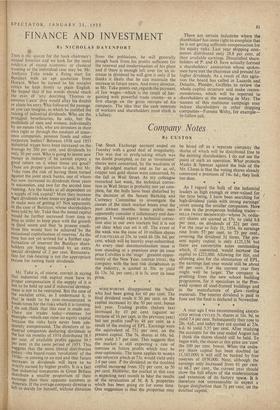Company Notes
By CUSTOS ,
THE Stock Exchange account ended on ruesday with a good deal of irregularity. fhis was due to profit-taking which was no doubt 'prompted, as far as 'investment' shares were concerned, by the weakness of the gilt-edged market and as far as oil, copper and gold shares were concerned, by the fall in Wall Street. As my colleague remarked last week, the technical correc- tion in Wall Street is probably not yet com- plete, for the bulls have been disturbed by the decision of the Senate Banking and Currency Committee to investigate the causes of the stock market boom over the past sixteen months. Some public men apparently consider it inflationary and dan- gerous. I would expect a technical correc- tion also in our own markets but iris not yet clear what can set it off. The event of the week was the issue of 10 million shares of coLVILLEs at 25s. to yield £6 18s. 6d. per cent, which will be heavily over-subscribed. As every steel denationalisation issue is now standing at a premium over its issue price Colvilles is the 'stags" greatest oppor- tunity of the New Year. UNITED STEEL, the company with the best risk distribution in the industry, is quoted at 30s. to yield £6 13s. 3d. per cent.; it is 5s. over its issue
price. •
WOOLWORTHS disappointed the 'bulls' who had been going for 60 per cent. The final dividend made it 50 per cent, on the capital increased by the 50 per cent. bonus last year. Trading profits (before tax) increased by 10 per cent. (against an increase of 16 per ceot. in the previous year) but net profits rose by 48 per cent, as a result of the ending of EPL. Earnings were the equivalent of 75+ per cent. on the present capital. The 5s. shares at 68s. 6d. now yield 3.7 per cent. This suggests that the market is still expecting a rate of inerease in future profits which may be over-optimistic. The same applies to MARKS AND SPENCER VhICh at 73s. would yield only 3.4 per cent. if the dividend on the doubled capital increased from 32# per cent, to 50 per cent. However, the market in this case is expecting next month to hear the results of the revaluation of M. & S. properties which has been going on for some time. One suggestion is that the properties may
be hived off as a separate company the shares of which will be distributed free to the existing shareholders. I do not see the point of such an operation. What protects Marks & Spencer against the bids of the Mr. Clores is that the voting shares already command a premium of 14s. 6d.; they look too dear.
•• • As I regard the bulk of the industrial leaders as high enough or over-valued for the time being, I have been searching for high-dividend yields with strong earnings' cover among the smaller companies. Here is one in the prosperous building trades- HILLS (WEST BROMWICH)-whose 5s. ordin- ary shares are quoted at 17s. to yield 6.6 per cent. on dividends of 22+- per cent. For the year to July 31, 1954, its earnings rose from 57 per cent. to 73 per cent., covering the dividend 3+ times. The pre- sent equity capital is, only £121,136 but there are convertible notes outstanding which, if converted, would increase the capital to £223,000. Allowing for this, and allowing also for the elimination of EPL, the earnings last year would still be about 60 per cent. For the current year they might well be larger. The company is profiting from the new school building programme, for it specialises in the Pres- weld system of steel-framed buildings and in the manufacture of glass - roofing materials. The interim dividend is paid in June and the final is declared in November.
• • • ,
A year ago I was recommending ASSOCI- ATED MOTOR CYCLES 5s. shares at 16s. 9d. to yield 7.4 per cent. Subsequently they rose to 28s. 44d., and today they are quoted at 23s. x.d. to yield 5.35 per cent. After studying the accounts for the year ended August last I think the shares should still be held. To begin with, the shares at this price are 'cum' the 100 per cent. bonus. When the ordin- ary share capital has been doubled (at £1,161,000) it will stiff be backed by free reserves of £656,000. Next, although the earnings only increased from 61 per cent. to 66.2 per cent., the current year should show the full effects of the modernisation and extension of its factory space. It Is therefore not unreasonable to expect a larger distribution than 71 per cent, on the doubled capital.
1


































 Previous page
Previous page